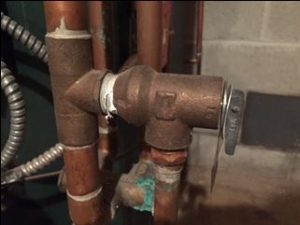Ticking and Banging Plumbing Pipes can be Infuriating to Home Occupants
By Mark J. Donovan
|
|
Hearing plumbing pipes bang every time a faucet or water drawing appliance shuts off can be annoying to the homeowner and unhealthy for the plumbing system. Similarly, hearing loud ticking sounds every time the hot water baseboard heating elements heat up or cool down can be irritating.
Moreover, listening to water running through drain pipes every time an upper level toilet is flushed can be grating on ones nerves. There are three main causes for these types of loud plumbing pipe noises in homes and fortunately there are a number of ways to silence loud plumbing pipes. |
Water Hammer
Banging supply plumbing pipes is associated with water hammer. Water hammer is due to high pressure in the plumbing supply lines. When a faucet, or an appliance that requires water, is turned off abruptly, the high pressure water in the pipe instantly backs up and consequently sends a shock wave through the pipe. The shock wave creates a loud banging sound that can often be heard throughout the home. Water hammer can also lead to eventual leaks in the plumbing system. Water hammer sounds are particularly exacerbated when the supply lines are not properly anchored to the framing within the home.
| Typically a good plumber will install water hammer arresters in the plumbing supply line system to prevent water hammer. Water hammer arresters are effectively small air chambers that reside above the water line in the supply plumbing pipes to act as shock absorbers when a tap or water requiring appliance shuts off. Water hammer arresters are normally constructed out of extra lengths of supply plumbing pipe.
You may also be able to silence loud banging pipes by anchoring them better to the framing, though the framing is often not very accessible. |
 |
This said, if you do have access to the plumbing supply lines, such as in the basement, you may want to install addition pipe hangers made out of plastic or nylon.
You may also want to consider reducing the water pressure a bit in the plumbing supply lines. By reducing the water pressure you can suppress the intensity of the banging pipes. This said, if not careful you may end up with inadequate water pressure in the upper levels of the home.
| Ticking Hot Water Baseboard Elements
The ticking sounds that you may hear when hot water baseboard heating elements heat up or cool down is due to the expansion and contraction of plumbing pipes and their subsequent rubbing against framing and flooring in the home. Often the loud ticking noises occur right where the supply line exits the floor to the heating element. To prevent the rubbing action and corresponding loud plumbing pipes you can insert plastic or nylon glides around the pipes where they exit the floor. |
|
Noisy Drain Pipes
Noisy drain pipes are caused from long vertical lengths of drain pipes that extend downward from upper level floors. The best way to silence loud drain plumbing pipes is to insulate around them when constructing the home, or even better locating them in walls not associated with prime living spaces. If you have access to the drain pipes in the basement you may want to talk with a plumber to see if the drain pipes can be modified in some way to reduce the noise, e.g. change the type of elbows that make the vertical to horizontal transitions more gradual.
For information on installing a shower pan membrane liner for a ceramic tile shower, see the Shower Pan Membrane Liner Installation eBook from HomeAdditionPlus.com. The Shower Pan Membrane Liner EBook will quickly teach you the step-by-step process for installing the shower pan membrane liner correctly. It includes instructions on framing the shower stall, pouring the pre-slope and shower base mortar, and installing the shower pan membrane liner.
For information on how to tile a custom ceramic tile shower, see the “How to Tile a Custom Ceramic Tile Shower eBook” from HomeAdditionPlus.com. This eBook will quickly provide you with step-by-step instructions on how to measure and install ceramic tile in a shower, including the installation of tile on shower walls, floors and curbs. It provides detailed instructions for every step in the process of tiling a custom ceramic tile shower and is loaded with instructional pictures!
Related Information
Additional Plumbing Resources from Amazon.com
 |
 |
Get Free Bathroom Remodeling Price Quotes with No Obligation!
Fill out our 3-5 minute quick and easy form, and receive a free price quote on a bathroom remodeling project from one of our pre-screened and licensed bathroom remodeling contractors. This process is free and there is no obligation to continue once you receive your bathroom addition price estimate.
